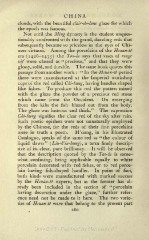Page 346 - Oriental Series Japan and China, Brinkly
P. 346
CHINA
clouds, with the beautiful clair-de-hine glaze for which
the epoch was famous.
Not until the Ming dynasty is the student unques-
tionably confronted with the grand, dazzling reds that
subsequently became so priceless in the eyes of Chi-
nese virtuosi. Among the porcelains of the Hsuan-te
era (14261435) the Tao-lu says that vases of rouge
vtf were classed as "precious," and that they were
glossy, solid, and durable. The same book quotes this
passage from another work : "In the Hsuan-te period
there were manufactured at the Imperial workshop
cups of the red called Chi-hung, having handles shaped
like fishes. To produce this red the potters mixed
with the glaze the powder of a precious red stone
which came from the Occident. On emerging
from the kiln the fish blazed out from the body.
The glaze was lustrous and thick." The expression
Chi-hung signifies the clear red of the sky after rain.
Such poetic epithets were not unnaturally employed
by the Chinese, for the reds of their fine porcelains
were in truth a poem. H'siang, in his Illustrated
red as " the colour of
lCiaqtuaildogduea,wnsp"ea(kLsiuo-ffttihae-husnagm}e, a term finely descrip-
tive of its clear, pure brilliancy. It will be observed
that the description quoted by the Tao-lu is some-
what confusing, being applicable equally to white
porcelain decorated with red fishes, or to red porce-
lain having fish-shaped handles. In point of fact,
both kinds were manufactured with marked success
by the Hsuan-te experts, but as the former has al-
"
ready been included in the section of porcelain
having decoration under the glaze," further refer-
ence need not be made to it here. The two varie-
ties of Hsuan-te ware that belong to the present part
280

